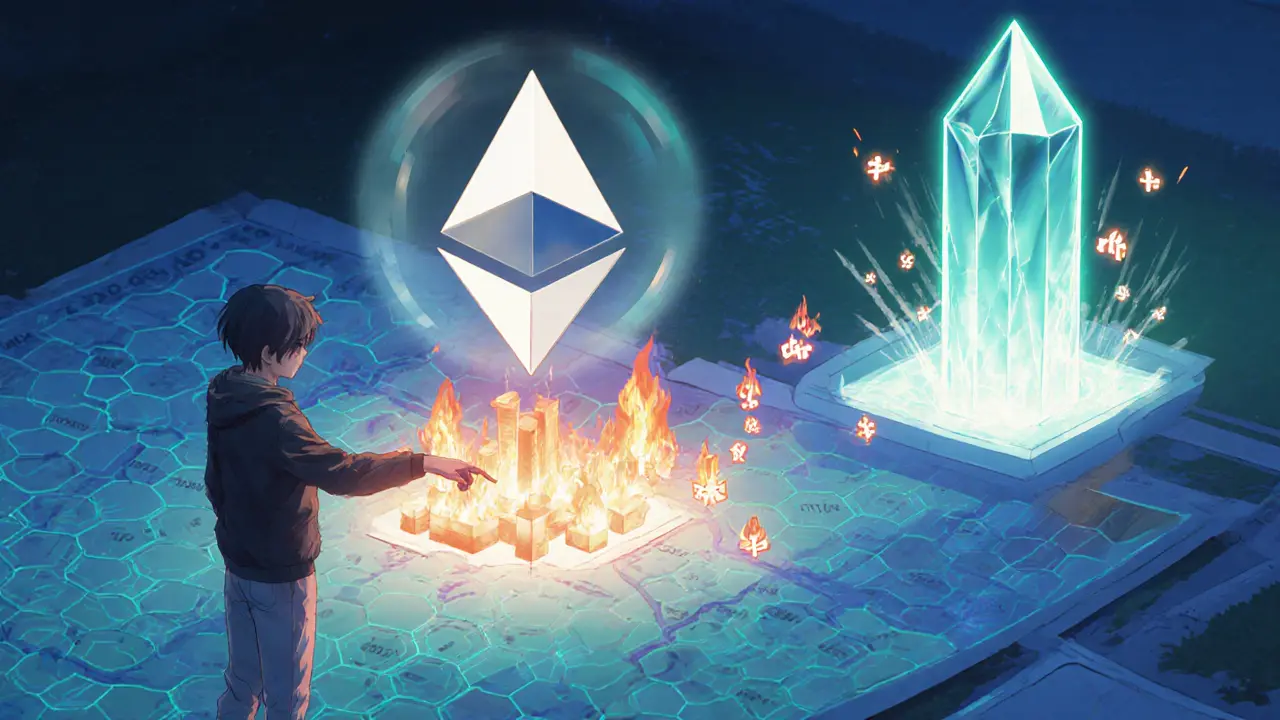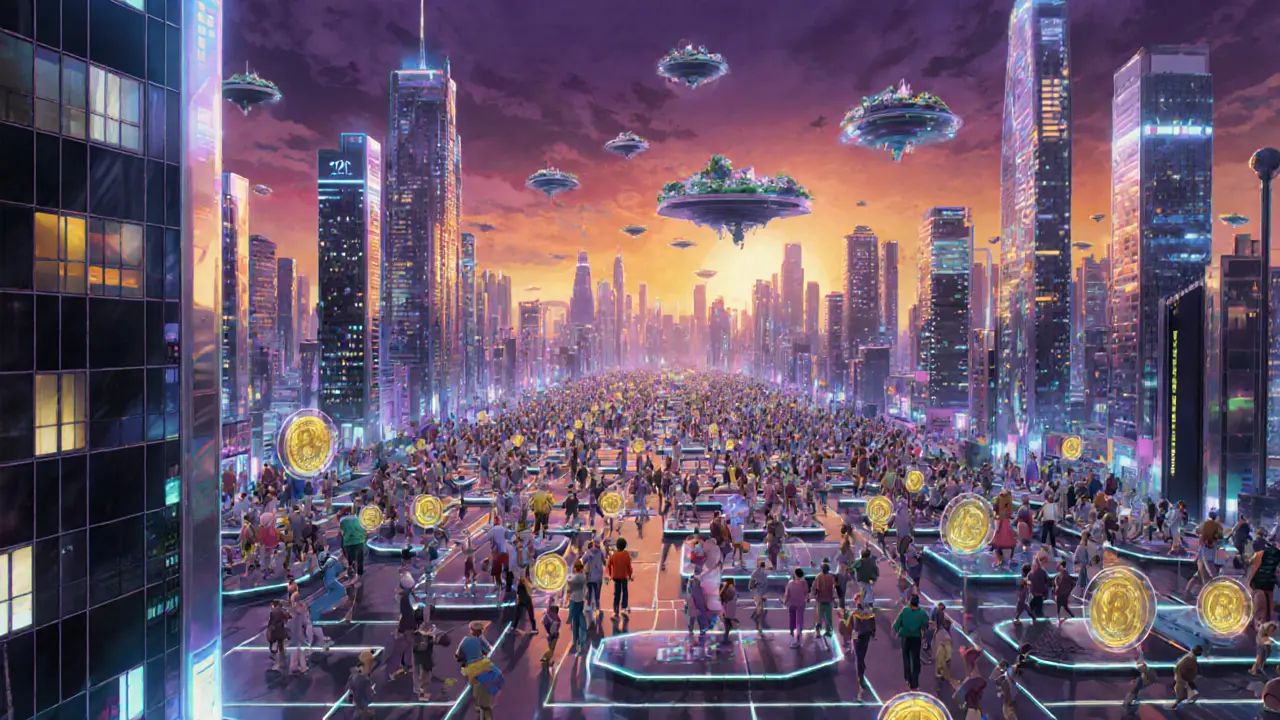Decentraland MANA Token Calculator
MANA Token Economics Calculator
Estimate potential returns from holding and staking MANA tokens in Decentraland's ecosystem.
Estimated Results
Enter values and click calculate to see your potential returns.
Key Takeaways
- Decentraland is a user‑owned virtual world built on Ethereum, powered by the MANA token.
- MANA is an ERC‑20 token used for buying land, goods, services, and for governing the platform.
- Virtual parcels are represented by LAND NFTs (ERC‑721) - there are exactly 90,601 of them.
- The ecosystem runs as a DAO, meaning token holders vote on policy, land auctions, and upgrades.
- MANA has a built‑in burn mechanism that reduces supply as the metaverse grows, creating a deflationary pressure.
When people ask, “What is Decentraland (MANA) crypto coin?” they’re looking for a clear picture of a virtual universe where a cryptocurrency is both cash and a voting badge. Below we break down the core concepts, token economics, how you actually use MANA, and what the future might hold.
Decentraland is a decentralized, 3‑D virtual reality platform built on the Ethereum blockchain. It lets users buy, build on, and monetize virtual land without a central authority. The platform launched in 2017 after an ICO and has since become one of the most recognizable metaverse projects.
How MANA Fits Into the Decentraland Ecosystem
MANA is an ERC‑20 token that serves two roles: a medium of exchange for everything inside Decentraland and a governance token for the Decentralized Autonomous Organization (DAO). Every transaction - from buying a plot of land to purchasing a virtual shirt - requires MANA. Holding MANA also grants voting power; token holders can fund new features, adjust land‑sale policies, or allocate community grants.
Virtual Land: The HEART of the Economy
The real estate layer is built on LAND ERC‑721 non‑fungible tokens that represent ownership of a specific 10m×10m parcel. There are exactly 90,601 parcels, each with a unique coordinate. Prices vary dramatically - prime downtown plots have sold for millions of dollars, while peripheral parcels might cost just a few hundred MANA.
Governance - Power to the Community
Decentraland lives under a DAO structure. Decentraland DAO allows MANA holders to propose and vote on platform upgrades, land auctions, or funding allocations. Proposals are submitted through the DAO portal, and a simple majority of voting tokens decides the outcome. This model eliminates a corporate owner and puts decision‑making directly in the hands of the community.
Tokenomics: Supply, Burns, and Staking
MANA launched with a total supply of 2.2billion tokens. The supply is not infinite - a portion of every transaction is automatically burned, permanently removing those tokens from circulation. This deflationary mechanism is designed to support price appreciation as more users join the world.
Additionally, users can stake MANA in “land pools.” Staking grants voting rights over specific parcels and a share of the revenue generated by activities on that land (e.g., game fees, event ticket sales). Staking also helps secure the DAO’s decision‑making process.

Technical Foundations
Decentraland runs on three main technologies:
- Ethereum provides the immutable ledger for MANA and LAND tokens.
- IPFS stores decentralized assets like 3‑D models, textures, and scene data.
- Standard web languages (HTML, CSS, JavaScript) power the scene builder, making it accessible to developers without specialized VR toolchains.
Because everything lives on public blockchains, ownership can be verified on any blockchain explorer, and assets can be transferred to external marketplaces such as OpenSea.
How to Get Started with MANA
- Set up an Ethereum‑compatible wallet (MetaMask, Coinbase Wallet, etc.).
- Buy MANA on a reputable exchange (Binance, Kraken, or a decentralized exchange like Uniswap).
- Transfer MANA to your wallet and connect the wallet to the Decentraland website.
- Visit the Marketplace to browse LAND parcels, wearables, or interactive experiences.
- If you’re a creator, use the Builder tool to design scenes, then mint your content as NFTs.
- Participate in DAO votes by locking MANA into the voting contract.
Comparison with Other Metaverse Tokens
| Feature | MANA | SAND (The Sandbox) | AXS (Axie Infinity) |
|---|---|---|---|
| Blockchain | Ethereum | Ethereum | Ethereum (side‑chain) |
| Primary Use | Land & governance | Land & game assets | Play‑to‑earn gaming |
| Supply Model | 2.2B, burn‑based deflation | 1B, fixed supply | 270M, staking rewards |
| Governance | DAO voting token | DAO voting token | DAO voting token |
| Land Count | 90,601 parcels | 166,464 parcels | None (game‑centric) |
Risks and Considerations
Investing or building in Decentraland isn’t risk‑free. Key points to watch:
- Market volatility: MANA’s price follows broader crypto trends.
- Liquidity of LAND: High‑price parcels may sit unsold for months.
- Technical barriers: Creating compelling 3‑D experiences still requires design skills.
- Regulatory environment: Changes in crypto regulations could affect trading on exchanges.
Doing due diligence, diversifying investments, and staying active in the community can mitigate many of these risks.
Future Outlook
Decentraland’s roadmap includes better VR support, deeper integration with DeFi protocols (e.g., lending against LAND), and expansion of the Creator Fund to reward high‑traffic experiences. As the broader metaverse market matures, the platform’s emphasis on user ownership and DAO governance could make it a preferred destination for developers who want full control over their creations.
Frequently Asked Questions
What is MANA used for inside Decentraland?
MANA is the native currency for buying LAND parcels, wearables, and in‑game items. It also serves as a voting token, letting holders influence platform upgrades, land‑sale rules, and community grants.
How do I acquire MANA?
You can purchase MANA on major exchanges like Binance, Kraken, or via decentralized exchanges such as Uniswap. After buying, transfer the tokens to an Ethereum‑compatible wallet and connect that wallet to the Decentraland marketplace.
Can I earn MANA without buying it?
Yes. Creators earn MANA when users pay to access their experiences, display ads, or purchase virtual goods. Staking MANA in land pools also yields a share of the revenue generated on those parcels.
What is the token burn mechanism?
A small percentage of every MANA transaction is automatically sent to an irretrievable address, permanently removing those tokens from circulation. Over time, this creates a deflationary effect that can support token value as the platform’s usage grows.
Is Decentraland compatible with VR headsets?
The platform can be accessed via a web browser on a regular computer, but it also supports Oculus Quest, HTC Vive, and other WebVR‑compatible headsets for a more immersive experience.

Alex Gatti
September 24, 2025 AT 22:32Decentraland is pretty wild its like a whole city built on crypto and you can actually own a piece of it with MANA
John Corey Turner
September 28, 2025 AT 12:15What really blows my mind is how the governance token model lets regular folks actually have a say in how the virtual city evolves, almost like a digital town hall where every vote can reshape a skyline or fund a community art project
Tyrone Tubero
October 2, 2025 AT 01:58Ah, the lofty dreams of a decentralized utopia where parcels of land are minted like digital relics, yet high‑falutin investors scoff and gamble with MANA as if it were gold dust in a pixel‑filled circus
Bhagwat Sen
October 5, 2025 AT 15:41Honestly the community vibe in Decentraland is something you have to feel in the chat lobbies and builder meet‑ups you can sense the energy when people showcase their galleries or host concerts
Cathy Ruff
October 9, 2025 AT 05:24Anyone still buying MANA should look at the price charts and realize this is a speculative bubble built on hype and not real utility
Marc Addington
October 12, 2025 AT 19:06Patriots of the crypto frontier must defend MANA as a symbol of American digital sovereignty against overseas meddling
Scott McReynolds
October 16, 2025 AT 08:49Decentraland offers a fascinating glimpse into how virtual economies can mimic the layers of real‑world markets, where land, goods, and services trade on a blockchain‑backed currency.
When you buy a parcel with MANA you are not just paying for pixels; you are staking a claim in a persistent, user‑governed world.
The DAO structure empowers token holders to propose and vote on everything from zoning laws to community grants, creating a shared sense of ownership.
Because the supply of LAND is capped at 90,601 parcels, scarcity can drive up demand for prime locations, much like downtown Manhattan.
Meanwhile, the burn mechanism subtly reduces the overall token supply, introducing a deflationary pressure that can support price appreciation over time.
Creators can monetize their experiences directly, earning MANA when users pay to access games, virtual concerts, or exclusive wearables.
This creates a feedback loop where quality content attracts more users, which in turn generates more revenue for builders.
Staking MANA in land pools gives participants a share of the revenue generated on those parcels, aligning incentives between users and developers.
The platform’s reliance on open standards like IPFS for asset storage ensures that digital creations remain immutable and portable.
Integration with major VR headsets also opens the door for immersive experiences that go beyond the flat browser view.
However, volatility remains a risk; MANA’s price can swing wildly with broader crypto market trends, affecting both investors and creators.
Liquidity for high‑value LAND can be limited, meaning some parcels may sit on the market for months without a buyer.
Technical barriers still exist – designing compelling 3‑D environments often requires specialized skills or tools.
Regulatory uncertainty around crypto assets could also impact exchange listings and user onboarding.
Overall, Decentraland stands as a pioneering experiment in virtual ownership, governance, and economy, offering both opportunities and challenges for those willing to dive in.
Adarsh Menon
October 19, 2025 AT 22:32Oh great another “metaverse” that will die when the next meme coin crashes, guess we’re all just renting digital apartments in a fantasy land
Laurie Kathiari
October 23, 2025 AT 12:15Honestly it’s absurd how people rave about “ownership” when all they’re doing is trusting a giant corporation’s code – the moral high ground feels misplaced
Promise Usoh
October 27, 2025 AT 01:58In reviewing the tokenomics of MANA, one observes a structured approach to supply control via periodic burns, which theoretically underpins a modest deflationary trajectory, albeit contingent upon sustained user adoption and transactional volume.
Lurline Wiese
October 30, 2025 AT 15:41Well, the drama of a virtual city isn’t just about the land – it’s about the stories people create, the concerts they host, and the memes that flood the chat.
Jenise Williams-Green
November 3, 2025 AT 05:24There’s a certain irony in championing a digital utopia while ignoring the very real exploitation of users’ time and attention; the metaverse promises freedom but often delivers fatigue.
Kortney Williams
November 6, 2025 AT 19:06I think it’s cool that MANA lets creators earn while they build, but newcomers should take it slow and learn the basics before buying pricey parcels.
Rob Watts
November 10, 2025 AT 08:49It’s great to see people getting into building and earning here but remember to stay safe watch out for scams and keep your wallet secure
Amy Harrison
November 13, 2025 AT 22:32Love seeing new creators pop up! 🎉 Keep experimenting and don’t be afraid to ask for help – the community is super supportive 😊
Natalie Rawley
November 17, 2025 AT 12:15Honestly most of the hype is just people trying to sound like they know blockchain, but the reality is you need solid design skills to make anything worthwhile.